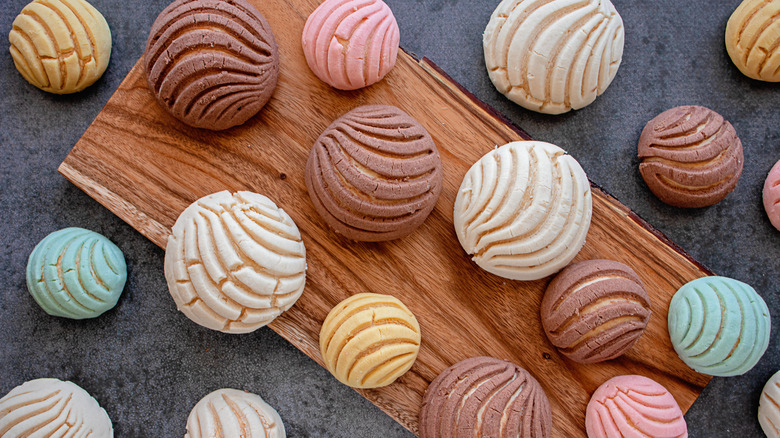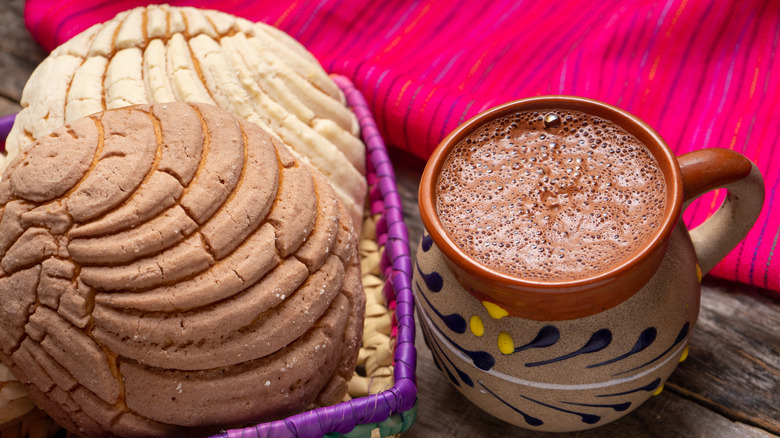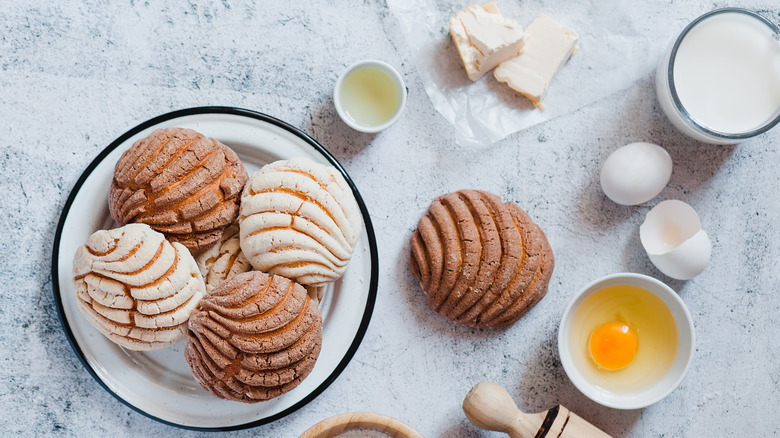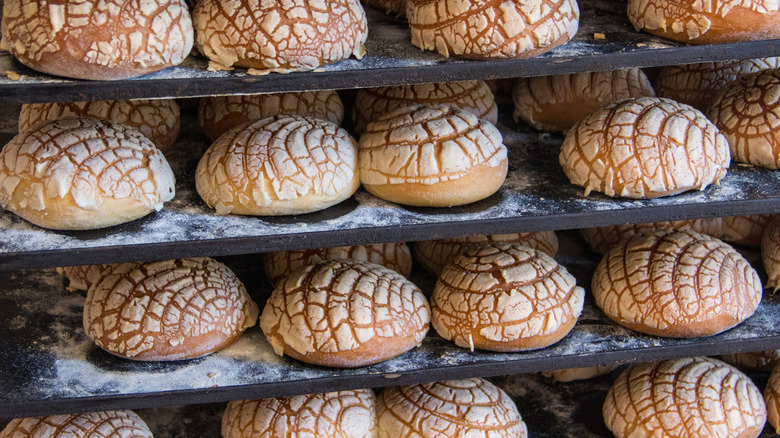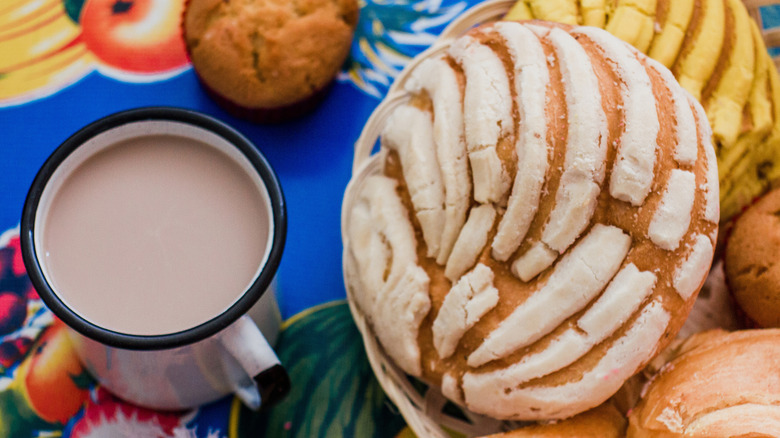Conchas: The Beautiful Shell-Inspired Mexican Sweet Bread
Conchas are classic Mexican pan dulces or sweet breads. The baked treat is known for its signature shell-like shape and pattern, per Serious Eats. Typically found in panderías both in Mexico and the United States, conchas (which means shells) are made of a pillowy enriched dough called biscocho, according to Thrillist.
A crackle-crust topping, similar to streusel, forms a shell pattern on top of the pastry. Classically white or brown, the conchas' topping can also be a wide variety of brilliant colors from yellow to pink, explains Mexico in My Kitchen. Conchas, while sweet, are appropriate for any meal of the day in addition to snacking.
Often, a warm beverage like milk or Mexican-style hot chocolate accompanies conchas. While perfectly delicious on their own, conchas are made heartier by halving and spreading beans, sometimes black beans and sour cream, on the two surfaces. Some people enjoy spreading natas — the filmy surface that appears on boiled raw milk — on their conchas. Others prefer a sweeter topping and opt for custard, says Eater. Traditionally, the concha dough is unflavored, but many modern bakers experiment with various creative flavors. Modern bakers have a lot of fun ingredients to draw inspiration from, but what sparked the creation of the very first conchas?
The origin of conchas
Conchas have a complex history, paralleling the colonization of Mexico. According to Eater, conchas most likely arose from French bakers who settled in Mexico after multiple invasions. When baked goods began to spread throughout Mexico, indigenous Mexicans most likely did not like the taste. Indigenous diets consisted of corn as the primary grain, whereas wheat-based baked goods were a part of the mandatory diet of enslaved indigenous people, explains WYKA.
Legend has it that the love of European-style baked goods rose to popularity across Mexico after a viceroy dipped his bread in a cup of sweet hot chocolate. He did so in front of a crowd of people, inspiring them to do the same. The sweet ritual spread and became a staple of Mexican cuisine.
Over time, the concha has followed the Mexican diaspora all over North, Central, and South America, reports Eater. While the concha has ties to brioche and challah, no one can pinpoint where the streusel topping originated. Interestingly, conchas resemble Japan's melonpan, a brioche-like bread topped with a similar cookie crust resembling a melon.
Conchas' ingredients
Today, concha dough ingredients include sugar, yeast, a liquid like water or milk, and fat. Most often, manteca de cerdo (lard) or butter acts as the fat, which makes the dough so delicate and airy, explains Serious Eats. Those using butter should always opt for unsalted butter since the salt will negatively impact the yeast (per WYKA).
Alternatively, some people prefer shortening or margarine as the recipe's fat. Either way, using only lard can flatten the pastry, so the site suggests adding butter to help preserve the dome-like shape. Some recipes for the topping also call for eggs, says Mexico in My Kitchen. Additionally, using bread flour helps maintain the pastry's spongey texture.
The ingredients of crackle crust topping include fat (typically butter or shortening), sugar, and flour (via Eater). Occasionally, people add both natural and artificial flavors to enhance both the enriched dough and the topping. Popular flavor additions include cinnamon, chocolate, and vanilla, the latter two of which are indigenous Mexican ingredients.
Tips for making conchas
Though the steps for making traditional Mexican conchas are relatively straightforward, you need time and planning ahead, advises Mely Martinez of Mexico in My Kitchen. It's best to make the whole recipe in the morning or to prepare the dough the night before and store it in the fridge overnight before baking. Regarding tools, using a stand mixer or a bread machine strengthens the dough's gluten.
First, make the dough and knead until the dough passes the "windowpane test," which means you can stretch a small part of the dough to translucency. Then set the dough aside to rise for up to 12 hours. After the first rise, cut the dough into individual roll-like pieces, advises Eater. While the dough rises for a second time, prepare the streusel topping, chill, and roll out the topping dough. Isabel Eats suggests using a tortilla press, rather than a rolling pin, for identical circular tops.
Before the concha rolls go in the oven, place the streusel topping on top, cut them into even circles on top of the rolls, and score them to create the shell-like pattern. For those wanting easy-to-make identical patterns, you can invest in a concha shell cutter to help make the pastry's lines. Once you've baked the conchas, you can enjoy them immediately, store them in an airtight container for up to five days, or freeze them for up to three months.
Conchas today
Recently, the concha has spread to communities across the United States. According to Thrillist, brothers David and Jóse Cáceres of Mexico City, who opened La Pandería in San Antonio, Texas in 2014 are significant contributors to this trend. Since then, pan dulces of all varieties have appeared in local bakeries and the likes of Michelin-starred Enrique Olvera's Cosme and Atla in New York City.
Manny Barella of Denver's Bellota explained the trend: "Just look at how popular a croissant is — I think they'll start catching on in the same way. You don't have to be a Mexican bakery to make conchas or appreciate them." Concha-themed festivals have arisen, like Concha Con in Los Angeles, Dia de la Concha in Chicago, and Concha Throwdown in San Antonio.
On social media, bakers and home chefs are riffing off the concha with viral success. These experiments include uniconchas (ombre-rainbow cookie crust), chocolate-dipped conchas, and even concha burgers, per WYKA.
With this comes innovations in flavors; Elisa Reyna of Maiz64 in Washington DC makes her conchas with cardamom and lavender cream. Roxxanne Delle Site-Jeronimo of Mexipino in Philadelphia infuses her conchas with ingredients from her Filipino heritage, such as ube jam and black bean paste (via Serious Eats). The simple pillowy texture and mildly sweet flavor of the original concha seem to be the perfect canvas for experimentation and improvisation with flavor and color.
